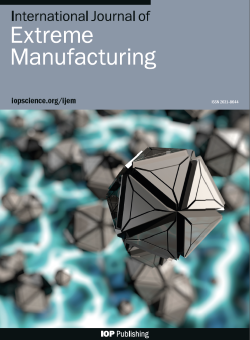Femtosecond laser ultrafast photothermal exsolution
IF 16.1
1区 工程技术
Q1 ENGINEERING, MANUFACTURING
引用次数: 0
Abstract
Exsolution, as an effective approach to construct particle-decorated interfaces, is still challenging to yield interfacial films rather than isolated particles. Inspired by in vivo near infrared laser photothermal therapy (PTT), using 3 mol.% Y2O3 stabilized tetragonal zirconia polycrystals (3Y-TZP) as host oxide matrix and iron-oxide (Fe3O4/γ-Fe2O3/α-Fe2O3) materials as photothermal modulator and exsolution resource, femtosecond laser ultrafast exsolution approach is presented enabling to conquer this challenge. The key is to trigger photothermal annealing behavior via femtosecond laser ablation to initialize phase transition into tetragonal zirconia (t-ZrO2) and induce columnar crystal growth, where Fe-ions rapidly segregate along grain boundaries and diffuse towards the outmost surface, becoming “frozen” there, highlighting the potential to use photothermal materials and ultrafast heating/quenching behaviors of femtosecond laser ablation for interfacial modification via exsolution. Triggering interfacial iron-oxide coloring exsolution is composition and concentration dependent, indicating photothermal materials themselves and corresponding photothermal transition capacity play a crucial role, initializing at 5wt%, 2wt%, and and 3wt% for Fe3O4-/γ-Fe2O3/α-Fe2O3 embedded 3Y-TZP samples. Due to different photothermal effects, exsolution states of ablated 5wt% Fe3O4-/γ-Fe2O3/α-Fe2O3-embedded 3Y-TZP samples are completely different, complete coverage, exhaustion (ablated away) and partial exsolution (rich in the crystal boundaries of sublayers). This novel exsolution is uniquely featured by up to now the deepest microscale (10 μm from 5 wt%-Fe3O4-3Y-TZP sample) Fe-elemental deficient layer for exsolution and the whole coverage of exsolved materials rather than formation of isolated exsolved particles by other methods. It is believed that femtosecond laser ultrafast photothermal exsolution may pave a good way to modulate interfacial properties for extensive applications in the fields of biology, optics/photonics, energy, catalysis, environment, etc.飞秒激光超快光热溶解技术
外溶解是构建颗粒装饰界面的一种有效方法,但要生成界面薄膜而不是孤立的颗粒仍具有挑战性。受体内近红外激光光热疗法(PTT)的启发,利用 3 mol.% Y2O3 稳定的四方氧化锆多晶体(3Y-TZP)作为主氧化物基质,氧化铁(Fe3O4/γ-Fe2O3/α-Fe2O3)材料作为光热调制剂和外溶资源,飞秒激光超快外溶方法的提出使我们能够战胜这一挑战。关键在于通过飞秒激光烧蚀触发光热退火行为,初始化相变为四方氧化锆(t-ZrO2),并诱导柱状晶生长,其中铁离子沿着晶界迅速偏析,并向最外层表面扩散,在那里被 "冻结",突出了利用光热材料和飞秒激光烧蚀的超快加热/淬火行为通过外溶解进行界面改性的潜力。触发界面氧化铁着色外溶解与成分和浓度有关,这表明光热材料本身和相应的光热转换能力起着至关重要的作用,对于Fe3O4-/γ-Fe2O3/α-Fe2O3包埋的3Y-TZP样品,在5wt%、2wt%和3wt%时初始化。由于光热效应不同,烧蚀 5wt% 的 Fe3O4-/γ-Fe2O3/α-Fe2O3 嵌入 3Y-TZP 样品的外溶解状态也完全不同,有完全覆盖、耗尽(烧蚀掉)和部分外溶解(富含子层的晶体边界)。这种新型外溶解的独特之处在于:迄今为止最深的微尺度(来自 5 wt%-Fe3O4-3Y-TZP 样品的 10 μm)缺铁元素外溶解层以及外溶解材料的整体覆盖,而不是其他方法形成的孤立外溶解颗粒。相信飞秒激光超快光热外溶解可以为调控界面性质铺平道路,在生物、光学/光子学、能源、催化、环境等领域得到广泛应用。
本文章由计算机程序翻译,如有差异,请以英文原文为准。
求助全文
约1分钟内获得全文
求助全文
来源期刊

International Journal of Extreme Manufacturing
Engineering-Industrial and Manufacturing Engineering
CiteScore
17.70
自引率
6.10%
发文量
83
审稿时长
12 weeks
期刊介绍:
The International Journal of Extreme Manufacturing (IJEM) focuses on publishing original articles and reviews related to the science and technology of manufacturing functional devices and systems with extreme dimensions and/or extreme functionalities. The journal covers a wide range of topics, from fundamental science to cutting-edge technologies that push the boundaries of currently known theories, methods, scales, environments, and performance. Extreme manufacturing encompasses various aspects such as manufacturing with extremely high energy density, ultrahigh precision, extremely small spatial and temporal scales, extremely intensive fields, and giant systems with extreme complexity and several factors. It encompasses multiple disciplines, including machinery, materials, optics, physics, chemistry, mechanics, and mathematics. The journal is interested in theories, processes, metrology, characterization, equipment, conditions, and system integration in extreme manufacturing. Additionally, it covers materials, structures, and devices with extreme functionalities.
文献相关原料
| 公司名称 | 产品信息 | 采购帮参考价格 |
|---|
 求助内容:
求助内容: 应助结果提醒方式:
应助结果提醒方式:


